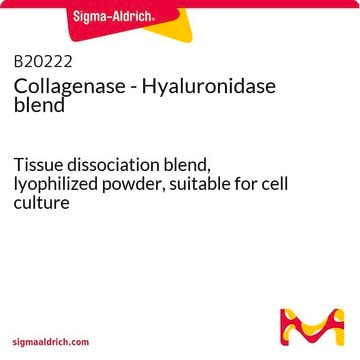B20221
Collagenase-DNase I blend
Tissue dissociation blend, lyophilized powder, suitable for cell culture
About This Item
Produits recommandés
Niveau de qualité
Forme
lyophilized powder
Activité spécifique
(Collagenase (FALGPA assay) 1.0-5.0 units/ml in 10 ml HBSS (#H6648))
(Deoxyribonuclease I activity: 200-2000 Kunitz units/ml in 10 ml HBSS (#H6648))
Température de stockage
-10 to -25°C
Description générale
Actions biochimiques/physiologiques
Notes préparatoires
Mention d'avertissement
Danger
Mentions de danger
Conseils de prudence
Classification des risques
Resp. Sens. 1
Code de la classe de stockage
13 - Non Combustible Solids
Classe de danger pour l'eau (WGK)
WGK 3
Point d'éclair (°F)
Not applicable
Point d'éclair (°C)
Not applicable
Certificats d'analyse (COA)
Recherchez un Certificats d'analyse (COA) en saisissant le numéro de lot du produit. Les numéros de lot figurent sur l'étiquette du produit après les mots "Lot" ou "Batch".
Déjà en possession de ce produit ?
Retrouvez la documentation relative aux produits que vous avez récemment achetés dans la Bibliothèque de documents.
Articles
Discover pre-mixed collagenase enzyme blends with DNase I, Dispase II, Elastase, and Hyaluronidase and gently dissociate animal tissues in vitro.
Notre équipe de scientifiques dispose d'une expérience dans tous les secteurs de la recherche, notamment en sciences de la vie, science des matériaux, synthèse chimique, chromatographie, analyse et dans de nombreux autres domaines..
Contacter notre Service technique








